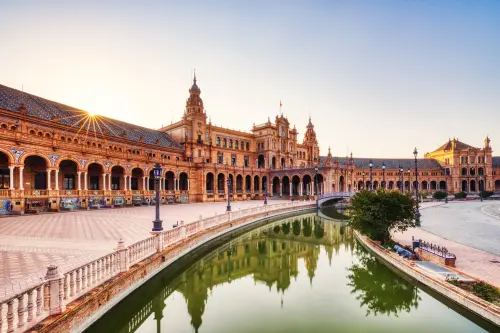As the country increasingly faces devastating floods, historic blizzards, and extreme droughts, there is an urgent need to take climate action. Adapting to these events is becoming a daily reality for many people and places, but avoiding the worst impacts in the long term depends on reducing greenhouse gas (GHG) emissions now. And while striving for GHG reductions globally and nationally matters, the ultimate responsibility rests in the hands of local leaders, who must plan and invest in sustainable infrastructure, land uses, and more.
A recent Brookings analysis showed that nearly every major U.S. city has adopted some form of climate action plan—a document pledging GHG reductions across the transportation sector, buildings, and other infrastructure. But cities often struggle to specify detailed strategies to execute on these pledges, including how to pay for them. A lack of fiscal, technical, and programmatic capacity is a huge barrier to action.
However, regional planning and action can help overcome these barriers in cities’ climate plans. This requires local leaders go beyond individual cities (or the urban core of a metro area) and coordinate with the suburban and exurban areas surrounding them. Doing so can address some of the country’s largest GHG emissions sources, which stretch across different jurisdictions—car-centric transportation networks, for instance—while also promoting scalable strategies in the process. And there is a huge federal carrot to doing so, including a recent Biden administration initiative that commits $250 million toward regional planning efforts and other innovative climate proposals.
The need for suburbs to take climate action is obvious, especially given their role fueling the sprawl that has exacerbated many of the country’s climate challenges over the last several decades. Yet the need for action might be even more urgent in exurbs, which are located at the fringes of major metro areas and have seen dramatic growth in recent years. GHG emissions continue to surge out of these areas, where larger single-family homes consume more energy, there is a greater reliance on personal vehicles, and spread-out communities lead to less walking and biking as well as longer drives.
In metropolitan regions, suburbs emit up to four times the household emissions of their urban cores. While households located in more densely populated neighborhoods have a carbon footprint 50% below the national average, those in the suburbs emit up to twice the average. In metro areas such as New York, GHG emissions in these outlying jurisdictions are readily apparent: Emissions in Manhattan average lower than 38 tons per household annually, but in exurban jurisdictions such as Sussex County, N.J., these emissions exceed 66 tons per household annually.
It’s also important to note that looking just at households does not fully capture all the emissions spilling out of these areas, such as those from far-flung industrial, commercial, and logistics activities. Fundamentally rethinking existing patterns of development may require widespread zoning changes, extensive building retrofits, and a surge in funding to consider new, more sustainable public infrastructure improvements. Yet political leadership may have an unwillingness to even consider new approaches.
Suburbs and exurbs may be adding to the country’s climate challenges, but they are also central to addressing them. After all, higher GHG emissions in these areas are not just the result of individual households and businesses—they are largely determined by the decisions of planners and policymakers. The amount of emissions depends on whether public transportation is available in neighborhoods, prevailing land uses, the design of buildings, and the types of energy sources available. Greater regional coordination on these factors can help advance climate action. City, suburban, and exurban leaders can work together across a variety of fronts, including:
- Setting clearer benchmarks and measurements to better chart their future climate plans and actions. To stimulate regional collaboration toward a more climate-friendly future, suburban and exurban leaders must be on the same page as their city peers. This includes publishing and publicizing data that shows climate change’s impact on the metropolitan region as a whole. In San Diego, for instance, the Climate Science Alliance gathered data on not just the city but the areas beyond to explain the regional impacts of climate change. This report led to regionwide meetings, educational workshops, and other events that brought city, suburban, and exurban actors together to discuss how climate change goals could be incorporated into their existing projects while also raising awareness of regional climate change issues in southern California.
- Specifying and acting on the funding and financing for their climate action plans. Any plan will remain only a plan if local leaders do not have the capacity—financial capacity, in particular—to implement needed infrastructure upgrades. Cities such as Portland, Ore. and Denver—which established climate funds by raising business and sales taxes—provide examples of ways in which climate finance programs can reach the local and regional levels and ensure that the entire metropolitan region can have access to the resources needed for implementation. Other regional models—including Portland’s Economic Value Atlas—demonstrate how ongoing planning for transportation and economic development can help leaders better target investments in more sustainable, equitable ways across multiple jurisdictions.
- Embracing regional entities that can bring together individual jurisdictions to create scalable climate action. Local governments at the city, suburban, and exurban levels should follow the example of existing metropolitan planning organizations and councils of governments to build and manage regional conversations and coordinate climate action strategies. The Chicago Metropolitan Agency for Planning is one such organization, which created ON TO 2050, a region-based, comprehensive plan to guide transportation investment and frame regional priorities on issues such as development, environment, and the economy. Establishing a similar regional network and strategy will likely run into political and logistical hurdles in many metro areas, but leaders have an opportunity to pool financial and other resources together to bargain for a coordinated strategy.
No city is an island. The relationship between urban cores and the suburbs and exurbs surrounding them should not be a one-way street in which only the central cities guide climate action. Leaders across entire regions need to look beyond the planning efforts of individual jurisdictions and test out new measurement approaches, investments, and collaborations to jump-start climate action at a greater geographic scale. Doing so not only offers promise in bridging climate planning gaps today, but also promoting more sustainable outcomes for years to come.
The Brookings Institution is committed to quality, independence, and impact.
We are supported by a diverse array of funders. In line with our values and policies, each Brookings publication represents the sole views of its author(s).






Commentary
It’s not just cities—suburbs and exurbs need to adopt and implement climate plans too
April 26, 2023